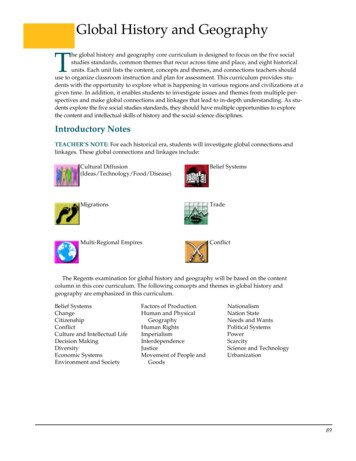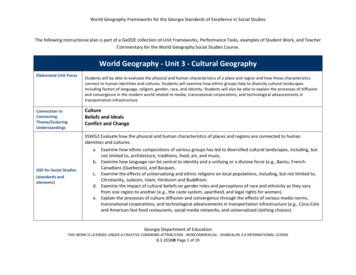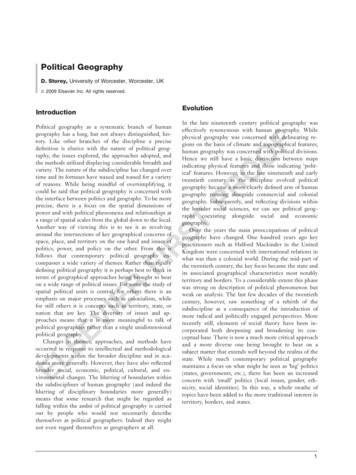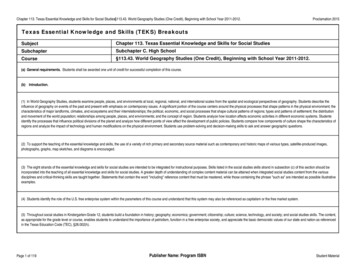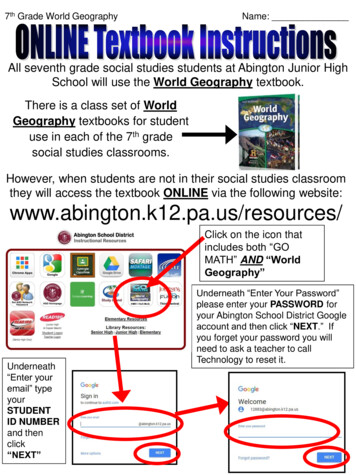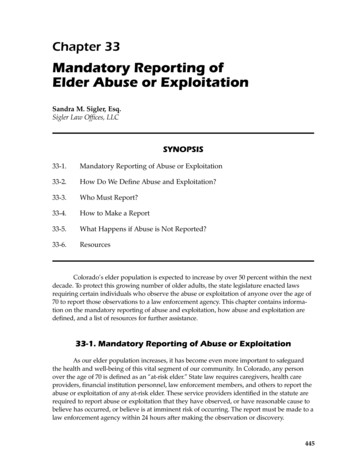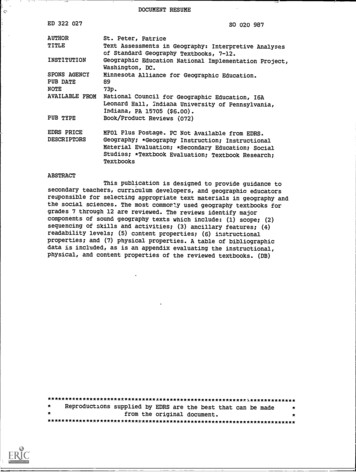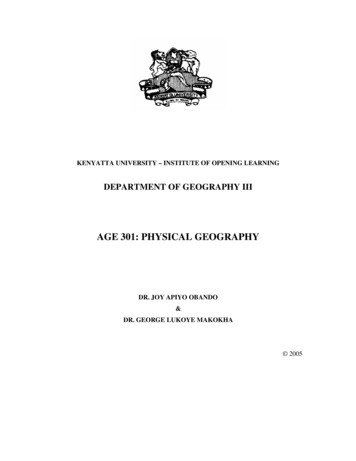
Transcription
M I N I S T RY O F E D U C AT I O NRepublic of GhanaTEACHING SYLLABUS FOR GEOGRAPHY(SENIOR HIGH SCHOOL 1 - 3)Enquiries and comments on this syllabus should be addressed to:The DirectorCurriculum Research and Development Division (CRDD)P. O. Box 2739Accra, Ghana.Tel: 0302-6836680302-683651September, 2010i
TEACHING SYLLABUS FOR GEOGRAPHY(SENIOR HIGH SCHOOL)RATIONALE FOR TEACHING GEOGRAPHYGeography studies the inter-relationships of the individual, physical and social environments both in spatial (relating to geographic space) and temporal (historicaltimes) terms. Issues of the environment are becoming increasingly important and geography, which studies the environment as a system, can and does providesolutions to environmental problems. Geography thus has a vital contribution to make towards the purpose of education, i.e., solving societal problems and furtherproviding the critical foundation knowledge in the development of Ghana.The value of geography lies in helping people to understand and adapt to the dynamics of the environment in which they live. The study of geography thereforeenables us to understand geographic facts without which it becomes impossible to acquire intimate knowledge of the environment we have to utilize toward ourdevelopment.Specifically, geography serves as one of the vehicles or tools for implementing the national educational objectives at the senior high school level by way of thefollowing:1.improving the communication skills of students, especially in the areas of describing and evaluating environmental concerns.2.providing students with knowledge and understanding of their communities, nation and the world.3.developing in them moral values and attitudes for appreciating nature‟s resources.4.equipping students with significant skills to enable them contribute towards improving on and sustaining the environment, e.g. landscaping (involving treeplanting and controlling or managing erosion).5.nurturing a generation of people who can think reflectively of others, respect their dignity and values which we as Ghanaians and members of the worldcommunity live for. Geography offers opportunities for mental training and intellectual development.6.enabling students to make an honest living in future. This refers to careers in geography that are open to the Senior High School graduate. The study ofgeography at this level will lay the foundation in areas such as map-work, human and regional geography. Thus, students who do not opt for highereducation at the tertiary level, would be able to find employment in the public and private sectors of the national economy, where they can serve asassistants to other professionals- i.e. Agronomists, Cartographers, Economists, Geographers, Regional and Urban Planners, Sociologists, Surveyors,Teachers etc.7.producing a generation of citizens imbued with the attitudes of co-operation, self-reliance, industry, self discipline and preparedness to be leaders as wellas followers.8.fostering national and international unity, better understanding of different geographical environments, cooperation of the various ethnic groups in thecountry toward national growth and development as well as reconciling differences among Ghanaians and other nationalities.9.acquiring skills for effective organization and utilization of space both in urban and rural environments thereby exposing students to the policies andprinciples underlying land use practices; recognition of the implications of rapid population growth, urbanization, rural-urban drift of the population and itsassociated rural depopulation, resource exploitation and utilization for socio-economic development and relevant measures for dealing with the impact ofpopulation growth on the environment.In sum, the contribution of geography to the education of the student at the Senior High School level finds expression in the communicative, cognitive (mentaldevelopment about environmental resources), affective (caring and protection of the environment) and psychomotor (hands-on-skills for environmentalmanagement) domains.ii
GENERAL AIMSThe syllabus is designed to help students to:1.use knowledge of the spatial relationships and the differences in character of the earth‟s surface in their lives and work2.recognize the relationship between the life of people, their physical environment and the concepts of individual-environment.3.develop empathy for people of other environments with different resources, goals and challenges from one‟s own area.4.acquire the skills of geographic investigation or field study i.e. collecting, classifying, analyzing and interpreting geographic data.5.acquire the basic knowledge about the nature of the physical and human environment.6.develop awareness of the nature and functioning of the physical and human elements and their inter-relationships.SCOPE OF CONTENTThe geography syllabus covers the planetary systems with emphasis on the earth as the planet habitable by humans, plants and animals. The principal issuesconcern the physical environments with the prospects and challenges of the human environment-relationships. The issue of understanding and interpreting maps,the geographical understanding of political divisions, identification and utilization of resources, livelihood activities that are and can be pursued in specificenvironments are also dealt with.ORGANIZATION OF THE SYLLABUSFor purposes of teaching and examining at the Senior High School level, the geography syllabus has been organized into three inter-related branches as follows:1.Physical Geography (Geomorphology,Climatology and Biogeography):This is the study of landforms, climate, weather, plant and animal life.2.Human and Regional Geography:This is the study of human economic activities and their classification on the basis of districts, regions and zones.3.Practical Geography:This involves the application of skills of map reading, map interpretation, data collection and analysis.These divisions should help students to acquire a sound basis in the study of geography. The following issues have been specifically considered:1. geography should be taught and learned with emphasis on interpreting the physical and human aspects of the subject.2. human and regional geography should be taught through themes.3. practical geography, involving map reading, analysis and interpretation (including statistical maps and diagrams), should be taught giving examples fromphysical, human and regional geography.The contents selected and the divisions adopted will ensure that students can actively and effectively utilize their knowledge in geography in the important task ofnation building. It is also expected that teachers will take note of the inter-relatedness of the three branches of the subject and make conscious efforts at teachingthe three areas as one, i.e., making references and giving examples that incorporate the three branches of the subject.The syllabus has been structured to cover the three years of the three-year Senior High School, that is, from SHS1 to SHS3. Each year‟s work comprises threesections with each section further divided into a number of units.The structure and organization of the syllabus is presented on the next page.iii
STRUCTURE AND ORGANIZATION OF THE SYLLABUSSHS1SHS2SECTION 1: PHYSICAL GEOGRAPHY - THE EARTHAS A PLANET (pg. 1-5)SECTION 1: PHYSICAL GEOGRAPHY: LANDFORMSUnit 1: The Planetary SystemUnit 1: The Hydrosphere (Lakes, Lagoons, Rivers,Oceans and Ocean Currents)Unit 2: The Earth: Rocks and MineralsUnit 3: The Earth‟s Atmosphere: Structure andCompositionUnit 4: Elements of Weather and Climate(pg. 13-20)Unit 2: Landforms of the Earth‟s Crust resulting from:a)b)c)Faulting and EarthquakesFoldingVulcanicitySHS3SECTION 1: PHYSICAL GEOGRAPHY: VEGETATION,SOILS AND ENVIRONMENTALCONCERNS (pg. 28-32)Unit 1: Vegetation (Types, Deforestation andConservation)Unit 2: Soils (Types, Erosion and Conservation)Unit 3: Environmental ConcernsUnit 3: External Sources of Landforms (Weathering andMass Wasting)Unit 4: Agents of Denudation and Associated LandformsSECTION 2: HUMAN AND REGIONAL GEOGRAPHY:POPULATION AND DISTRIBUTION (pg.6-9)Unit 1: Population: Size, Structure and DistributionUnit 2: Settlements: Rural and UrbanSECTION 2: HUMAN AND REGIONAL GEOGRAPHY:ECONOMIC ACTIVITIES (pg. 21-24)SECTION 2: HUMAN AND REGIONAL GEOGRAPHY:GHANA AND AFRICA (pg. 33-39)Unit 1: Economic Activities (Primary, Secondary andUnit 1: Ghana: Size, Location, Physical and EconomicTertiary)EnvironmentUnit 2: Renewable and Non-renewable EnergyResourcesUnit 2: Africa including West Africa: Size, Location,Physical and Economic EnvironmentUnit 3: Regional groupings in AfricaSECTION 3: PRACTICAL GEOGRAPHY – USINGMAPS (10-12)SECTION 3: PRACTICAL GEOGRAPHY: READINGMAPS (pg. 25-27)Unit 1: Elements of Map ReadingUnit 1: Principles of Geographic InvestigationUnit 2: Principles of Elementary SurveyingUnit 2: Statistical Maps and DiagramsSECTION 3: PRACTICAL GEOGRAPHY: MAPINTERPRETATION AND MAP USE(pg. 40)Unit 1: Elements of Map Interpretation and Map useUnit 3: Principles of Map ReadingREFERENCES (pg. 41)iv
TIME ALLOCATIONstGeography is allocated 6 periods of 40 minutes each per week throughout the 1 , 2ndrdand the 3 years.RESOURCES NEEDED Assorted map extracts for map reading Survey instruments: prismatic compass, chain, tape measure, arrow, ranging poles, Global Position System (GPS) Globes, Digital Camera, Computer, CDs of various geographical featuresSUGGESTIONS FOR TEACHING THE SYLLABUSWith the present increase in the number of periods, preferably three teachers should teach the subject. Each branch (Physical Geography, Human and RegionalGeography and Practical Geography) should be taught by a different teacher. The three branches should be taught simultaneously throughout the three years ofstudy. The branches of geography have also been classified into units to emphasize the competencies to be acquired by students. It is envisaged that the structurewill enable students to be reflective and participate effectively in the teaching and learning process.In teaching geography, teachers should maintain an open classroom climate consistent with cooperative discussion methods in current teaching methodology.Teachers should make conscious efforts to involve students in sharing their daily experiences of human environment-relations and encourage them to explore theirimmediate environment in relation to the geography syllabus. This will help students to appreciate their immediate school environment and translate their cognitive(knowledge) into positive attitudes to protect and maintain the environment.General ObjectivesGeneral Objectives have been provided at the beginning of each Section. The General Objectives specify the skills and behaviours students should acquire as aresult of learning the units of a section. Teachers are expected to read the General Objectives very carefully before planning to teach a Section. After teaching allthe Units of the Section, teachers should go back and read the General Objectives again to be sure the objectives have been adequately covered in the course ofteaching.Sections and UnitsThe syllabus has been planned in Sections and Units. Each year‟s work has been divided into three Sections. A Section consists of a fairly homogeneous body ofknowledge within the subject. Within each Section are Units. A unit consists of a more related and homogeneous body of knowledge and skills. The teacher isexpected to consider the total number of Sections and associated number of Units prescribed for each year and plan the scheme of work and lessons for eachterm such that the work in all the Sections and Units for each particular class will be completed by the end of the school year.Each Section of the syllabus is structured in five columns: Units, Specific Objectives, Content, Teaching and Learning Activities and Evaluation. A description ofthe contents of each column is as follows:Column 1 – Units: The Units in column 1 are divisions of the major topic of the Section. You are expected to follow the unit topics according to the linear order inwhich they have been presented. However, if you find at some point that teaching and learning in your class will be more effective if you branch to another Unitbefore coming back to the Unit in the sequence, you are encouraged to do so. The order in which the Units will be taught depends of course on your scheme ofwork.Column 2 – Specific Objectives: Column 2 shows the Specific Objectives for each Unit. The Specific Objectives begin with numbers as 1.3.2 or 2.2.1. Thesenumbers are referred to as “Syllabus Reference Numbers” or SRN. The first digit in the Syllabus Reference Number refers to the Section; the second digit refersto the Unit, while the third digit refers to the serial number of the Specific Objective. For instance, 1.3.2 means: Section 1 (of the appropriate year‟s syllabus), Unit3 (of Section 1) and Specific Objective 2. In other words, 1.3.2 refers to Specific Objective 2 of Unit 3 of Section 1. Similarly, the Syllabus Reference Number2.2.1 means Syllabus Objective number 1 of Unit 2 of Section 2. Using Syllabus Reference Numbers provides an easy way for communication among teachersv
and other educators. It further provides an easy way for selecting objectives for test construction. Assuming that Unit 2 of Section 2 has five specific objectives,2.2.1 – 2.2.5, a teacher may want to base his/her test items/questions on objectives 2.2.3 and 2.2.4 and not use the other three objectives. In this way, a teachercould sample the objectives within Units and within Sections to be able to develop a test that accurately reflects the importance of the various skills and knowledgetaught in class.You will note also that Specific Objectives have been stated in terms of the student i.e. what the student will be able to do after instruction and learning in the unit.Each Specific Objective hence starts with the following, “The student will be able to.” This in effect, means that you have to address the learning challenges ofeach individual student. It means individualizing your instruction as much as possible such that the majority of students will be able to achieve the objectives ofeach unit of the syllabus.PROFILE DIMENSIONSProfile dimensions describe the underlying behaviours or abilities students are expected to acquire as a result of having gone through a period of instruction. Eachof the specific objectives in this syllabus contains an action verb that specifies the type of learning or skill that the student should acquire by the end of theinstructional period. For example, a specific objective will be stated as follows: The student will be able to describe etc. contains an action verb "describe" thatindicates what the student will be able to do after teaching and learning have taken place. Being able to "describe" something after the instruction has beencompleted means that the student has acquired "knowledge". Being able to explain, summarise, give examples, etc. means that the student has understood thelesson taught. Similarly, being able to develop, plan, construct, etc. means that the student has learnt to create, innovate or synthesize knowledge. Each of theaction verbs in the specific objectives of the syllabus describes the behaviour the student will be able to demonstrate after the instruction. "Knowledge","Application", etc. are dimensions that should be the prime focus of teaching, learning and assessment in schools.In Geography, the three profile dimensions that have been specified for teaching, learning and assessment are:Knowledge and UnderstandingApplication of KnowledgeAttitudes, Values and Process Skills40%40%20%Each of the dimensions has been given a percentage weight that should be considered in teaching, learning and testing. The weights indicated on the right of thedimensions show the relative emphasis that the teacher should give in the teaching, learning and assessment processes.Emphasizing the three dimensions in your teaching will ensure that Geography will not only be taught and studied at the cognitive level but will also lead studentsto the acquisition of positive attitudes and values that will enable them to deal effectively with issues in geography and with issues in life in general.vi
The explanation and key words involved in each of the profile dimensions are as follows:Knowledge and Understanding (KU)Knowledge:The ability to remember, recall, identify, define, describe, list, name, match, state principles, facts and concepts. Knowledge is the abilityto remember or recall material already learned and this constitutes one of the levels of learning.Understanding:The ability to explain, summarize, translate, rewrite, paraphrase, give examples, generalize, estimate or predict consequences basedupon a trend. Understanding is generally the ability to grasp the meaning of some material that may be verbal, pictorial, or symbolic.Application of Knowledge (AK)This dimension is also referred to as “Use of Knowledge”. Ability to use knowledge or apply knowledge, as implied in this syllabus, has a number of learningbehaviour levels. These levels include application, analysis, creativity, innovation or synthesis, and evaluation. These may be considered and taught separately,paying attention to reflect each of them equally in your teaching. The dimension “Application of Knowledge” is a summary dimension for all four learning sublevels. Details of each of the four sub-levels are as follows:Application:The ability to apply rules, methods, principles, theories, etc. to concrete situations that are new and unfamiliar. It also involves the abilityto produce, solve, demonstrate, discover, etc.Analysis:The ability to break down material into its component parts; to differentiate, compare, distinguish, outline, separate, identify significantpoints etc., ability to recognize unstated assumptions and logical fallacies; ability to recognize inferences from facts, etc.Innovation/CreativityThe ability toput parts together to form a new whole. It involves the ability to synthesize, combine, compile, compose, devise, suggest a new idea orpossible ways, plan, revise, design, organize, create, and generate new solutions. The ability to create or innovate is the highest form oflearning. The world becomes more comfortable because some people, based on their learning, generate new ideas, design and createnew things.EvaluationThe ability to:appraise, compare features of different things and make comments or judgments, contrast, criticize, justify, support, discuss, conclude,make recommendations etc. Evaluation refers to the ability to judge the worth or value of some materials, ideas etc., based on somecriteria. Evaluation is a constant decision making activity. We generally compare, appraise and select throughout the day. Every decisionwe make involves evaluation. Evaluation is a high level ability just as application, analysis and innovation or creativity since it goes beyondsimple knowledge acquisition and understanding.The action verbs provided under the various profile dimensions should help you to structure your teaching so as to achieve the effects needed. Select from theaction verbs provided for your teaching, for evaluation exercises and for test construction. Check the weights of the profile dimensions to ensure that you havegiven the required emphasis to each of the dimensions in your teaching and assessment.FORM OF ASSESSMENTIn developing assessment procedures, select specific objectives in such a way that you will be able to assess a representative sample of the syllabus objectives bythe end of the school year. Each specific objective in the syllabus is considered a criterion to be achieved by the student. When you develop a test that consistsvii
of items or questions that are based on a representative sample of the specific objectives taught, the test is referred to as a “Criterion-Referenced Test”. In manycases, a teacher cannot test all the objectives taught in a term, in a year etc. The assessment procedure you use i.e. class tests, home work, projects etc. must bedeveloped in such a way that the various procedures complement one another to provide a representative sample of the important objectives taught over a period.Assessment at Senior High School 1-3 (Elective)The table below shows the recommended examination structure for SHS1-3. The structure consists of two examination papers: Paper 1 and Paper 2. The twoexamination papers must be taken at separate sittings. Paper 1 has two sections, A and B. Section A is made up of items on general geography. This is a 50minutes test consisting of 50 multiple choice questions covering the entire geography syllabus except elementary surveying. Section B covers elements ofPractical and Physical Geography. This section consists of 8 questions to be answered in one hour and fifty minutes. Students are expected to answer 4questions. Question 1, which is compulsory, is based on Map Reading and Interpretation.Paper 2 consists of questions on Human and Regional Geography. This is a two-hour essay-type paper consisting of 3 Sections, A, B, & C. Students are requiredto attempt 4 questions out of 9 choosing at least one from each section. Section A is on Human Geography of the world; Section B is Regional Geography ofGhana, and Section C is Geography of Africa.Paper 1 is marked over 120 marks. Paper 2 is marked over 80 marks giving a total mark of 200 for the two papers. The total number of marks should be convertedto 100 for grading. The raw score mark ratio between Paper 1 and 2 is 60:40. This ratio is maintained in the examination paper structure below.TEST DIMENSIONSDistribution of Examination Paper Weights and MarksPAPER 1PAPER 2General GeographyHuman and Regional GeographyABABCObjectiveEssayThe WorldGhanaAfricaTestTOTALSWeights ofDimensionsKnowledge and Understanding252571588040%Application of Knowledge20251015108040%Attitudes and Process Skills52031024020%TOTALS (Raw Scores)5070204020200100%100100%Conversion to 1006040GUIDELINES FOR SCHOOL BASED ASSESSMENTA new School Based Assessment system (SBA) will be introduced into the school system in 2011. The new SBA system is designed to provide schools with aninternal assessment system that will help schools to achieve the following purposes:oooooStandardize the practice of internal school-based assessment in all Senior High Schools in the countryProvide reduced assessment tasks for subjects studied at SHSProvide teachers with guidelines for constructing assessment items/questions and other assessment tasksIntroduce standards of achievement in each subject and in each SHS classProvide guidance in marking and grading of test items/questions and other assessment tasksviii
Introduce a system of moderation that will ensure accuracy and reliability of teachers‟ marksProvide teachers with advice on how to conduct remedial instruction on difficult areas of the syllabus to improve class performance.ooThe arrangement for SBA may be grouped in categories as follows: Project, Mid-Term test, Group Exercise and End of Term Examination.Project: This will consist of a selected topic to be carried out by groups of students for a year. Segments of the project will be carried out each term toward the finalproject completion at the end of the year, The project may consist ofi)ii)iii)Investigative studyPractical workCase StudyMid-Term Test: The mid-term test following a prescribed format will form part of the SBAGroup Exercise: This will consist of written assignments or practical work on a topic(s) considered important or complicated in the term‟s syllabusEnd-of-Tem Examination: The end-of-term test is a summative assessment system and should consist of the knowledge and skills students have acquired in theterm. The end-of-term test for Term 3 for example, should be composed of items/questions based on the specific objectives studied over the three terms,using a different weighting system such as to reflect the importance of the work done in each term in appropriate proportions. For example, a teacher maybuild an End-of-Term 3 test in such a way that it would consist of the 20% of the objectives studied in Term 1, 20% of objectives studied in Term 2 and60% of the objectives studied in Term 3.Students are expected to undertake assignments that may involve investigations, surveys, interviews etc. as home work and as part of the SBA. The followingguidelines are provided for making written SBA assignments of such nature.1.2.3.4.Introduction (including acknowledgement)Data collection and analysisConclusions and recommendationsReferences10%50%20%20%GRADING PROCEDURETo improve assessment and grading and also introduce uniformity in schools, it is recommended that schools adopt the following WASSCE grade structure forassigning grades on students‟ test results. The WASSCE structure is as follows:Grade A1:Grade B2:Grade B3:Grade C4:Grade C5:Grade C6:Grade D7:Grade D8:Grade F9:80 - 100%70 - 79%60 - 69%55 - 59%50 - 54%45 - 49%40 - 44%35 - 39%34% and below-ExcellentVery GoodGoodCreditCreditCreditPassPassFailix
In assigning grades to students‟ test results, you are encouraged to apply the above grade boundaries and the descriptors which indicate the meaning of eachgrade. The grade boundaries i.e., 60-69%, 50-54% etc., are the grade cut-off scores. For instance, the grade cut-off score for B2 grade is 70-79% in the example.When you adopt a fixed cut-off score grading system as in this example, you are using the criterion-referenced grading system. By this system a student mustmake a specified score to be awarded the requisite grade. This system of grading challenges students to study harder to earn better grades. It is hence a veryuseful system for grading achievement tests.Always remember to develop and use a marking scheme for marking your class examination scripts. A marking scheme consists of the points for the best answeryou expect for each question, and the marks allocated for each point raised by the student as well as the total marks for the question. For instance, if a questioncarries 20 marks and you expect 6 points in the best answer, you could allocate 3 marks or part of it (depending upon the quality of the points raised by thestudent) to each point , hence totaling 18 marks, and then give the remaining 2 marks or part of it for organization of answer. For objective test papers you maydevelop an answer key to speed up the marking.x
SENIOR HIGH SCHOOL - YEAR 1SECTION 1PHYSICAL GEOGRAPHY (GEOMORPHOLOGY, CLIMATOLOGY, BIOGEOGRAPHY)General Objectives: The student will:1.2.3.4.UNITSSPECIFIC OBJECTIVESUNIT 1The student will be able to:THE PLANETARYSYSTEM: THEPLANET EARTH1.1.1identify the positionof the variousplanets in relationto the sun and theearth.acquire basic knowledge about the nature of the physical environment.be aware of how the physical environment functions.be aware of the inter-relationships between the physical and human environments.acquire basic knowledge about the nature of the climatic environment.CONTENTTEACHING AND LEARNING ACTIVITIESThe sun is at the centre of the planetary system. All theother planets, including the earth revolve around it. Theearth in addition to revolution, rotates on its own axis.The earth is spherical in shape.Students to: list and sketch the orbital paths of theplanets. discuss the relationship between thesun at the centre of the universe andthe earth as one of the planets. use atlases, maps and globes toidentify latitudes and longitudes andshow the differences in their uses. use the internet to view pictures ofspace exploration. use different sources, such as journals,magazines, newspapers, the internetetc. to find out why Pluto is no longerrecognized as a planet.Class exerciseDraw and label theplanetary system.Students to demonstrate the differencesbetween revolution and rotation of the earthin space and their resultant effects usingthe globe and torch light.Class exerciseShow the calculation oftime betweensettlements on differentlongitudes.Class assignmentWrite the differencesbetween the earth‟srotation on its axis andrevolution around thesun.The planets are: Mercury, Venus, Earth, Mars, Jupiter,Saturn, Uranus and Neptune.Note: Recent scientific discovery indicates that Pluto isno longer recognized as an existing planet. It is nowtermed a “dwarf planet”1.1.2explain effects ofrevolution androtation of theearth.Revolution of the earth causes:i) solstices and equinoxes.ii) seasons (winter, spring, summer, autumn)Rotation of the earth causes day and night and also thedifference in time.1EVALUATION
UNITSSPECIFIC OBJECTIVESUNIT 2The student will be able to:STRUCTURE OFTHE EARTH,ROCKS ANDMINERALS1.2.11.2.2describe thestructure of theearth.describe the types ofrocks, their modes offormation andcharacteristics.CONTENTTEACHING AND LEARNING ACTIVITIESThe earth‟s structure comprises four concentric zonesnamely: the inner core the outer core the mantle which is made up of molten rockcalled magma. the crust: a discontinuous mass of rocksseparated by the hydrosphere (water bodies). Itis made up of two categories of rocks the SIALand SIMA.The atmosphere forms part of the earth‟s structure.Students to draw and label the earth‟sstructure and describe it.There are generally three types of rocks. Igneous rocks Sedimentary rocks Metamorphic rocksAssist students to describe the formation ofeach of the three types of rocks.The classification is essentially based on the mode offormation of the rock type.1.2.3explain theimportance of rocksand minerals tonationaldevelopment.Importance of rocks For construction (roads and buildings) As source of fuel (e.g. coal) As source of raw materials for industry e.g. glass,alumina from bauxite, limestone for cement,industrial diamond, etc. As ornaments and jewellery e.g. gold, silver,bronze As a source of internal revenue e.g. ro
Geography offers opportunities for mental training and intellectual development. 6. enabling students to make an honest living in future. This refers to careers in geography that are open to the Senior High School graduate. The study of geography at this level will lay the foundation in areas such as
